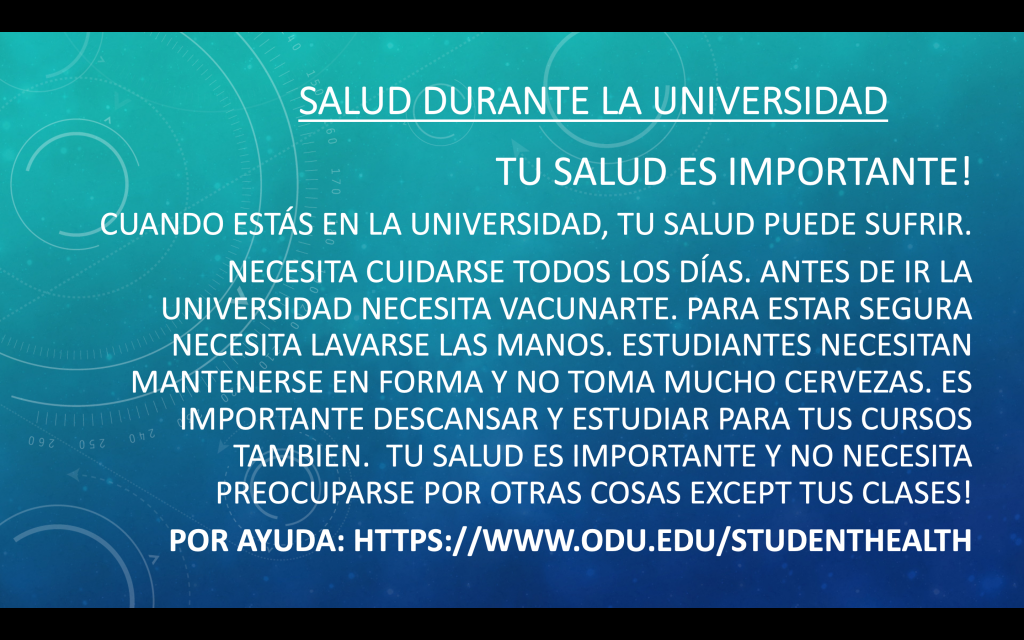Interpretive, Interpersonal, and Presentational Modes of Communication
Address the reflection exercises in each of the following sections. For each section, you will need to embed portions of these assignments and activities as artifacts to substantiate your reflection. Then, at the end of each section, include a link to the document or embed it as a PDF.
Tutorials are available:
- Embedding a PDF
- Embedding Media (Images, Audio)
- Embedding a Video
An Effective Reflection Is
- Written in English.
- A demonstration, explanation, comparison of skill and growth described through what you learned and the challenges you had in that learning while highlighting your best work.
- A discussion of how you overcame any weakness or obstacles. Explain what you mean.
- Supported by evidence as represented by your artifacts (course materials, photographs, video, conversations, projects, news reports, authentic materials, etc.).
- Specific, addressing particular strengths, weakness, skills, transformative experiences, etc., avoiding vague generalizations (ex: “I learned a lot.”).
An Effective Reflection is not
- Only sharing an artifact without context or discussion.
- Only a description or explanation of an artifact. Focus on your learning and growth as a result of having completed that experience.
- An attempt to justify your work to an instructor. Instead, think more broadly about future audiences that might benefit from seeing evidence of your work and the skills you are developing.
Exploring Culture
During this semester, not only did we learn about the Spanish language, but also the culture. It is enriching to learn about other cultures, especially if you’re like me, and you have not ever traveled outside of the United States. I liked the utilization of YouTube videos to get a feel for the culture of various countries, as well as the LingroLearning cultural assignments. I feel more involved with my Spanish educational journey when I learn about the culture that surrounds Spanish-speakers.
By viewing the YouTube videos and reading the cultural aspects in LingroLearning, I learned more in-depth topics about the Hispanic culture than I have before. I learned about the typical routines, common foods, and some of their practices. I have never traveled outside of the US, so learning this kind of information about another country is so interesting to me. I also learned that things we do here in the US seem just as weird to other countries as some of the things we do here. Everywhere is unique and has culturally different backgrounds, which makes our world so rich. Gaining knowledge about this culture has made me realize just how badly I desire to travel to a predominantly Spanish speaking country.
Engaging in Communities
The value of engaging in your community is indescribable. It is so important to engage in your community because by doing so, you are opening up a new door in your life by beginning to know your community and those in it in a way you possibly never have before. You never know who or what is around you until you get up and find these things out for yourself. Engaging in your community is not only beneficial and enriching to you, but also the community as a whole.
Recently, when I started my job as a Paraprofessional at a middle school in my city, I began to become a part of my community in a way I would have never imagined. I have made such amazing relationships with fellow teachers, students, administrators, and parents. It has been such a gratifying experience to become familiar with those around me and create long-lasting relationships.
Interpersonal Communication
At the beginning of the semester when I learned that we were expanding to include having recorded conversations with native Spanish speakers, I was very intimidated. After completing these assignments this semester, I realized how beneficial they were to my knowledge of the language. In addition, the Zoom sessions I had with Professor Guadaño helped me immensely, allowing me to get immediate feedback on my pronunciations, structures, and vocabulary.
The TalkAbroad activities were, like I previously stated, intimidating. It was nerve-wracking to know that I would be speaking with someone whose first language is Spanish and that I would be somewhat expected to be able to decipher what is being said and asked. After completing the activities in TalkAbroad, I learned just how beneficial it is to speak with a native speaker. They speak fast and fluently, and you must follow along and be able to understand what they are saying and asking you. I overcame my fears of completing these activities by just studying and relying on my knowledge to get me where I need to be. I have learned techniques to use over the course of completing these activities that will help me in my future endeavors in my Spanish journey.
Presentational Speaking
This semester we were required to complete a few activities that required us to record ourselves speaking in Spanish about different topics with different goals for each. Outside of class, I often go to Mexican restaurants and I sometimes will order in Spanish or just try to have a conversation in Spanish with the employees. Usually, it goes well and they seem happy to see me trying to utilize my Spanish.
https://drive.google.com/file/d/1Sg2QDboRLHSXcysvPPyoSlocHPwUrHX3/view?usp=sharing
In the above assignment, the goal was to show and describe ourselves and our families. I really enjoyed this assignment, as the vocabulary used for the majority was things I have previously learned and was just building upon. I excelled at saying exactly what I meant because I have mastered that vocabulary set. My goal is to become this confident for all of my Spanish vocabulary by the end of my academic career.
Presentational Writing
Over the course of the semester, we were required to complete various writing presentations. These ranged from ads, pamphlets, and discussion board posts.
The project I included above was an assignment that required us to create an ad for ODU students about their health and where to get help. I struggled some with the vocabulary of this unit, so creating a cohesive ad was difficult. I tried as best as I could to use my knowledge of grammar and vocabulary to create an informative ad. I will definitely aim to master the vocabulary next time, so that I can put together these assignments with ease and accuracy.
Interpretive Listening
Throughout the semester, we had multiple meetings with Professor Guandaño, where he assessed us, as well as where we, in a way, assessed him. By that I mean, in order to excel in these activities, we had to be able to assess what he was saying to us in Spanish and how to respond appropriately.
Not only did we have one-on-one conversations with Professor Guadaño, we also completed modules and activities in LingroLearning that had listening aspects. Sometimes it was difficult to follow along, decipher what was being said, and choosing the right answer based on the audio recordings, but I feel that this is one of the most beneficial modes of learning a new language, besides speaking it, of course.
Interpretive Reading
Over the course of the semester, we participated in various discussion boards, with some of them being linked with an article for us to read and respond to. We also has activities on LingroLearning where we had to decipher and add to text message excerpts, letters, and emails.
The reading activities were some of the most difficult for me. Reading in another language requires you to think deeply about what is being said, by using vocabulary and grammatical aspects. Once I became lost in a sentence of paragraph, I would have to read it over and over again to finally grasp what was being said. It is interesting reading in Spanish, because if you rely heavily on translating the material into English, you will sometimes get wacky translations, because English and Spanish are so different. Each reading assignment, I left with an overall better understanding of the vocabulary and grammar, which helped me become more confident in my Spanish abilities.

